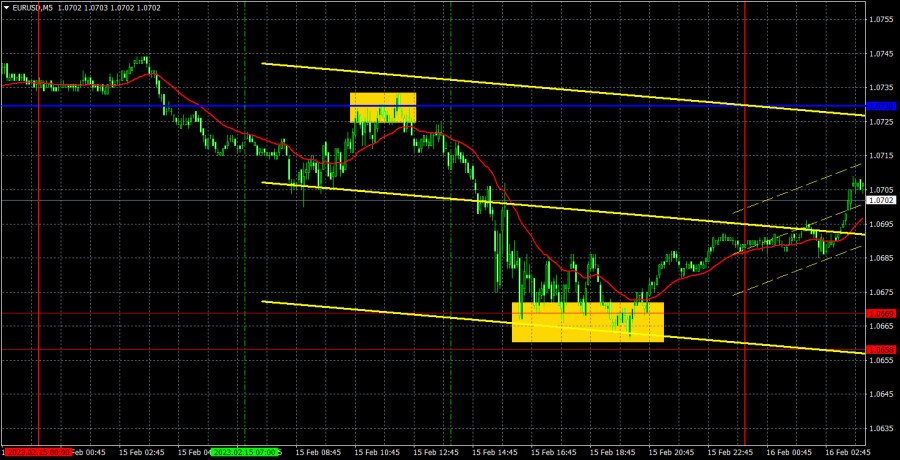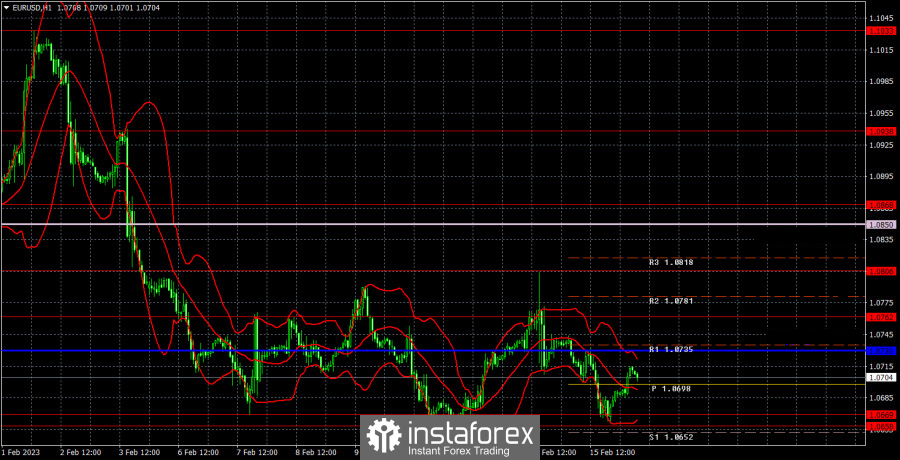

The EUR/USD currency pair dropped to its local "bottom" in the area of 1.0658–1.0669 on the third trading day of the week. The euro currency fell on Wednesday for a variety of reasons. First off, we continue to anticipate the decline of the euro as part of a global correction. Second, the European Union's December industrial production report came in below expectations. Finally, the report on retail sales for January in the US nearly doubled expectations. Hence, the decline was entirely reasonable and logical. It was anticipated that the dollar would increase significantly following the US inflation report. Although most of the foreign exchange market remains dependent on rates, monetary policy, and the rhetoric of central bank representatives, the euro currency does not have sufficient reasons to resume its upward trend after a slight pullback. We think the decline should keep going.
With trading signals yesterday, everything was rather straightforward. In the middle of the European session, the pair bounced off the pivotal line; following that, it dropped to the range of 1.0658-1.0669. It stated that traders might make around 45 points. The area's rebound was a sell signal, and there were numerous of them, but the pair couldn't get up even 15 points, and it couldn't get a foothold below the designated area either. As a result, only the purchase transaction could be used, and it had to be manually closed. There could be no loss.
COT Report
The recent COT reports on the euro are entirely consistent with market activity. The aforementioned image makes it very evident that from the start of September, the net position of significant players (the second indicator) has been improving. At about the same time, the value of the euro started to increase. Although the net position of non-commercial traders is currently "bullish" and growing virtually weekly, it is the relatively high value of the "net position" that now permits the upward trend's impending end. This is shown by the first indicator, which frequently occurs before the end of a trend and shows that the red and green lines are very far away from one another. The number of buy contracts from the "non-commercial" group increased by 9.5 thousand during the most recent reporting week, while the number of short positions decreased by 2,000. The net position consequently increased by 7.5 thousand contracts. For non-commercial traders, there are currently 134 thousand more buy contracts than sell contracts. It is now unclear why there haven't been any new COT reports released in the last two weeks. As a result, up to this point, we have to work with the available data. Nonetheless, the correction has been developing for a while, so it is obvious even without news that the pair should keep falling.
EUR/USD 1H analysis.

In the hourly time frame, the pair continues to be down and has once again deviated from the key line. As a result, while there is a downward trend, a flat is starting to form between the levels of 1.0669 and 1.0806. A new attempt to increase by 100 points may be attempted in the upcoming days since there was a rebound from the lower border of the side channel yesterday. For trading on Thursday, we set aside the following levels: 1.0485, 1.0581, 1.0658–1.0669, 1.0762, 1.0806–1.0868, and 1.0938, as well as the Senkou Span B (1.0850) and Kijun-sen (1.0730) lines. The Ichimoku indicator's lines might move during the day, therefore, this should be considered while choosing trade signals. Other support and resistance levels exist as well, but no signals are created close to them. Remember to place a stop-loss order at breakeven if the price moves up or down by 15 points. If the signal turns out to be false, this will shield against potential losses. There are no significant events scheduled for February 16 in the European Union, however, the United States will release figures on the number of construction licenses issued, the producer price index, and applications for unemployment benefits. We consider these reports to be secondary, and we do not anticipate a significant market response. Today, the pair might stay inside the side channel.
Explanations for the illustrations:
Thick red lines represent price levels of support and resistance (resistance/support), where the movement may stop. They don't provide trading signals, though.
The Ichimoku indicator's Kijun-sen and Senkou Span B lines have been moved from the 4-hour timeframe to the hourly one.
The price previously bounced off of the tiny red lines that represent extreme levels. They provide signals for trading.
Trend lines, trend channels, and other technical patterns are represented by yellow lines.
The net position size of each trading category is represented by indicator 1 on the COT charts.
The net position size for the "non-commercial" category is shown by indicator 2 on the COT charts.